| Editor’s note: |
| Today’s interviewee, Andrea Fields will be speaking at the 2019 STEM Education Conference in June at Cleveland State University, presented in partnership with the Ohio STEM Learning Network. Registration is $30 and closes May 15. Register here. To learn more about the conference, read our interview with organizer Dr. Kate O’Hara. |
When she first heard about the new MC2 STEM High School in Cleveland, Andrea Fields wasn’t impressed. Even though she liked to “tinker” with things, she didn’t want to go to high school year-round. But she ended up becoming a founding freshman at the school, as well as a manager of its Mobile Fab Lab. Through the Mobile Fab Lab, she spread her growing interest in digital fabrication learning opportunities to STEM schools across Ohio and even attended an international conference in Peru. After graduation from MC2, Fields continued her work with Fab Labs and schools and organizations, becoming a trainer and consultant as she pursued two degrees in civil engineering at Cleveland State University. Fields has given speeches on STEM learning and minority women in STEM, including an inspiring TED talk. As she finishes up her work toward a bachelor’s degree, and then a master’s, we asked her to answer a few questions about her journey:
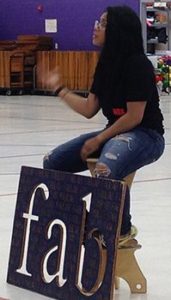
Q: Tell us about how you became a founding student at MC2 STEM High School in Cleveland? Were you always interested in all things mechanical?
A: I was a part of a focus group of students to get our opinions about a new school that the Cleveland Metropolitan School District was starting. At first I was completely disengaged after they said it would be a year-round school. At that time, they weren’t sure what the summers would look like so I wasn’t interested in attending the school but still provided my feedback.
I was always tinkering with things, but never put an exact name on it. My family would get upset if I took something apart because I would most likely change the way it worked, usually for the better.
Q: How did your subsequent education at MC2 STEM and your work in the Fab Lab there influence your education path? What especially sparked your interest there, and how did your teachers play a role?
A: My art teacher, Nick DiGiorgio, was the teacher who saw a leadership side of me within the Mobile Fab Lab and provided me with opportunities to show myself what he had already seen in me. My engineering teacher, Brian McCalla, saw the engineering side of me and exposed me to the world of engineering in multiple disciplines.
My teachers never specifically told me to do this or that but always let me figure out which way my education and experiences would take me. MC2 STEM gave me different perspectives on problem solving, whether it’s a workable solution or not. I was able to critically think and was given the freedom to make mistakes and continue to try over and over again until I became proficient regardless of the test. The Fab Lab was my outlet to do that.
Being a part of the first class of a new school we didn’t have all the sports a traditional school would have, so my outlet became bringing the ideas in my mind to life.

Q: Tell us about your role in taking the Fab Lab “on the road.” Where did you go, and what did you do once you were there? What was your favorite part of these “field trips”?
A: In 2010, Mobile Fab Lab became a part of MC2 STEM, and I was a volunteer for it. As a high school student I had to have a specific amount of community hours, and the Mobile Fab Lab was a fun way to both get out of school and make an impact. I didn’t know that it was going to shape my future opportunities and be a crucial part of my education.
The goal of the Mobile Fab Lab was to expose others (students, teachers, community members) to the type of education and access to equipment we were getting at MC2 STEM High School.
We traveled to many regional schools (elementary through high school), maker-faires, conferences and events. My favorite part of these trips was watching teachers’ minds change from skeptical to passionate about something that was so foreign to them.
Selected photos from Andrea of showing her work with the FabLab
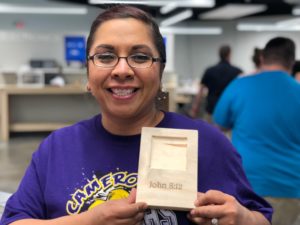 |
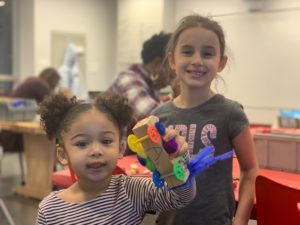 |
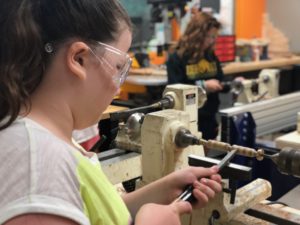 |
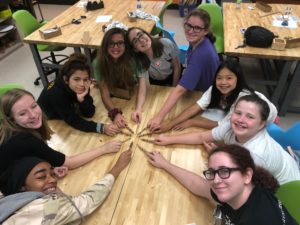 |
Q: You’ve also been abroad. Tell us about your experience in Lima, Peru.
A: When I was a junior in high school, I was asked to be one of two first high school students to go to the international Fab Lab Convention (which is in a different country every year) in Lima, Peru. This was the first time that I had been out of the country. I represented our school and high school students in general. This was the first time that high school students were a part of the convention, and it was life changing.
It was different seeing poverty in another country and how hard life can be in reality versus seeing it on TV or in a movie. Installing digital fabrication tools and giving people access to these tools was indescribable.
Coming home, none of my friends really understood what I was trying to explain to them, but I knew I had to change the way I lived and thought. Since that trip I have gone to conferences in Spain, the United States and France as a speaker, facilitator and guest.
Q: Since graduation, how have you stayed connected with Cleveland schools and other organizations to further the mission of Fab Labs?
A: Since graduation, I have worked in several Fab Labs as an installer, instructor, trainer and manager. I work with a company called TIES that has been instrumental in including me as an option for clients to have as a resource.
Currently, I am managing a middle school Fab Lab at Brady Middle School in the Orange Schools district in Pepper Pike, Ohio. I was originally hired to install the machines and train teachers during a summer session. Once I received my college course schedule, I submitted it to the administration and figured they would want a full-time person, because that is what I suggested during the install. But the teachers were really great, and I wanted to give it a shot and got the job.
I am finishing up my two years with the middle school in May and have trained an assistant manager along the way to take over fully once I am gone.
Q: What are your plans after graduation from Cleveland State University? Will you still be involved with Fab Labs, or do you have other goals?
A: I am graduating with my bachelor’s degree in civil engineering in May and then will receive my master’s in civil engineering in December of this year.
Once I am finished, my family and I are moving to Los Angeles where I will further pursue my engineering career and Fab Lab career, as well. Helping others bring their ideas to life is something that is priceless to me, and I could never fully stop being involved with Fab Labs. It has truly become a passion for me.
Additional photos from Andrea
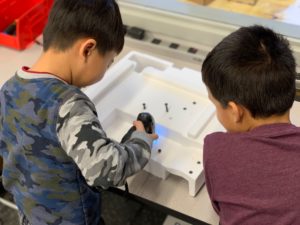 |
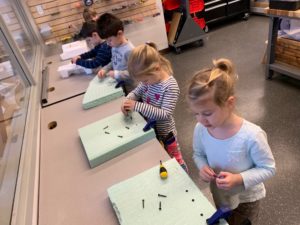 |
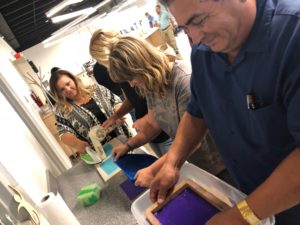 |
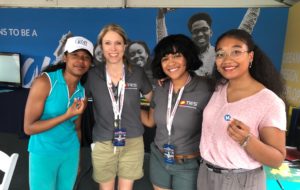 |
Q: What has been your driving philosophy in regard to Fab Labs in particular and STEM education in general?
A: Whether you want to be a doctor, teacher, journalist or an engineer, STEM is a way of thinking. Since high school, I have seen results of this deeper thinking and learning across all ages and how effective it is. This is what keeps me going – even when the politics around me makes me not want to continue, the students, regardless of age, remind me why I do it all.
Q: What would you advise other educators who might be considering installing a Fab Lab or a similar room in their school?
A: It is very easy to consider the Fab Lab just as an art extension or not worth time out of your busy classroom day, but I encourage you to think of the lab as another tool.
These tools can enhance and engage students in a deeper way than simple pencil and paper could never articulate. It is not just for key chains and stickers, although that is usually the first thing you make. It’s for diving deeper into the topic at hand. Being able to manipulate theoretical ideas and bring them to life is no easy task, but well worth it in the end.
Have an open mind, be OK with failing a lot, and you will truly see the benefits through your students.